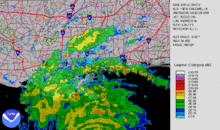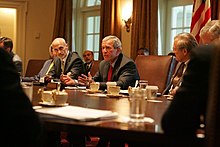Hurricane Katrina formed as Tropical Depression Twelve over the
southeastern Bahamas on August 23, 2005, as the result of an interaction
of a
tropical wave and the remains of
Tropical Depression Ten. The system was upgraded to
tropical storm status on the morning of August 24 and at this point, the storm was given the name
Katrina. The tropical storm continued to move towards Florida, and became a hurricane only two hours before it made
landfall between
Hallandale Beach and
Aventura
on the morning of August 25. The storm weakened over land, but it
regained hurricane status about one hour after entering the Gulf of
Mexico.
[1]
The storm
rapidly intensified
after entering the Gulf, growing from a Category 3 hurricane to a
Category 5 hurricane in just nine hours. This rapid growth was due to
the storm's movement over the "unusually warm"
waters of the
Loop Current, which increased wind speeds.
[8] On Saturday, August 27, the storm reached Category 3 intensity on the
Saffir-Simpson Hurricane Scale, becoming the third
major hurricane of the season. An
eyewall replacement cycle
disrupted the intensification, but caused the storm to nearly double in
size. Katrina again rapidly intensified, attaining Category 5 status on
the morning of August 28 and reached its peak strength at 1800 UTC that
day, with maximum sustained winds of 175 mph (280 km/h) and a minimum
central
pressure of 902
mbar (26.6
inHg).
The pressure measurement made Katrina the fourth most intense Atlantic
hurricane on record at the time, only to be surpassed by Hurricanes
Rita and
Wilma later in the season; it was also the strongest hurricane ever recorded in the
Gulf of Mexico at the time. However, this record was later broken by Hurricane Rita.
[1]
Katrina made its second landfall at 1110 UTC (6:10 a.m. CDT) on
Monday, August 29 as a Category 3 hurricane with sustained winds of
125 mph (205 km/h) near
Buras-Triumph, Louisiana.
At landfall, hurricane-force winds extended outward 120 miles (190 km)
from the center and the storm's central pressure was 920 mbar (27 inHg).
After moving over southeastern Louisiana and
Breton Sound,
it made its third landfall near the Louisiana/Mississippi border with
120 mph (195 km/h) sustained winds, still at Category 3 intensity.
Katrina maintained strength well into Mississippi, finally losing
hurricane strength more than 150 miles (240 km) inland near
Meridian, Mississippi. It was downgraded to a tropical depression near
Clarksville, Tennessee, but its remnants were last distinguishable in the eastern
Great Lakes region on August 31, when it was absorbed by a
frontal boundary. The resulting
extratropical storm moved rapidly to the northeast and affected eastern Canada.
[1]
Preparations
Federal government
On the morning of Friday, August 26, at 10 am
CDT (1500
UTC),
Katrina had strengthened to a Category 3 storm in the Gulf of Mexico.
Later that afternoon, the NHC realized that Katrina had yet to make the
turn toward the Florida Panhandle and ended up revising the predicted
track of the storm from the panhandle to the Mississippi coast.
[9][10]
The NHC issued a hurricane watch for southeastern Louisiana, including
the New Orleans area at 10 am CDT Saturday, August 27. That afternoon
the NHC extended the watch to cover the Mississippi and Alabama
coastlines as well as the Louisiana coast to
Intracoastal City.
The
United States Coast Guard
began prepositioning resources in a ring around the expected impact
zone and activated more than 400 reservists. On August 27, it moved its
personnel out of the New Orleans region prior to the mandatory
evacuation.
[11] Aircrews from the Aviation Training Center, in Mobile, staged rescue aircraft from Texas to Florida.
[12] All aircraft were returning towards the Gulf of Mexico by the afternoon of August 29. Air
crews,
many of whom lost their homes during the hurricane, began a
round-the-clock rescue effort in New Orleans, and along the Mississippi
and Alabama coastlines.
[13]
President of the United States
George W. Bush
declared a state of emergency in selected regions of Louisiana,
Alabama, and Mississippi on Saturday, the 27th, two days before the
hurricane made landfall.
[14]
That same evening, the NHC upgraded the storm alert status from
hurricane watch to hurricane warning over the stretch of coastline
between
Morgan City, Louisiana
to the Alabama-Florida border, 12 hours after the watch alert had been
issued, and also issued a tropical storm warning for the westernmost
Florida Panhandle.
[1]
During video conferences involving the president on August 28 and 29, the director of the National Hurricane Center,
Max Mayfield,
expressed concern that Katrina might push its storm surge over the
city's levees and flood walls. In one conference, he stated, "I do not
think anyone can tell you with confidence right now whether the levees
will be topped or not, but that's obviously a very, very great concern."
[15]
On Sunday, August 28, as the sheer size of Katrina became clear, the
NHC extended the tropical storm warning zone to cover most of the
Louisiana coastline and a larger portion of the
Florida Panhandle. The National Weather Service's New Orleans/Baton Rouge office issued a
vividly worded bulletin
predicting that the area would be "uninhabitable for weeks" after
"devastating damage" caused by Katrina, which at that time rivaled the
intensity of
Hurricane Camille.
[16]
"On Sunday, August 28, President Bush spoke with Governor Blanco to
encourage her to order a mandatory evacuation of New Orleans." (Per page
235 of Special Report of the Committee on Homeland Security and
Governmental Affairs)
[17]
Voluntary and mandatory evacuations were issued for large areas of
southeast Louisiana as well as coastal Mississippi and Alabama. About
1.2 million residents of the Gulf Coast were covered under a voluntary
or mandatory evacuation order.
[1]
Investigation of State of Emergency declaration
In a September 26, 2005 hearing, former FEMA chief
Michael Brown testified before a U.S. House subcommittee about FEMA's response. During that hearing, Representative
Stephen Buyer
(R-IN) inquired as to why President Bush's declaration of state of
emergency of August 27 had not included the coastal parishes of Orleans,
Jefferson, and Plaquemines.
[18] (In fact, the declaration did not include
any of Louisiana's coastal parishes, whereas the coastal counties were included in the declarations for Mississippi
[19] and Alabama.
[20]) Brown testified that this was because Louisiana
Governor Blanco
had not included those parishes in her initial request for aid, a
decision that he found "shocking." After the hearing, Blanco released a
copy of her letter, which showed she had requested assistance for "all
the southeastern parishes including the City of New Orleans" as well
specifically naming 14 parishes including Jefferson, Orleans and
Plaquemines.
[21]
Gulf Coast

Radar loop of Hurricane Katrina making landfall in Louisiana
On August 26, the state of Mississippi activated its
National Guard
in preparation for the storm's landfall. Additionally, the state
government activated its Emergency Operations Center the next day, and
local governments began issuing evacuation orders. By 6:00 pm
CDT
on August 28, 11 counties and eleven cities issued evacuation orders, a
number which increased to 41 counties and 61 cities by the following
morning. Moreover, 57 emergency shelters were established on coastal
communities, with 31 additional shelters available to open if needed.
[7]
Louisiana's hurricane evacuation plan calls for local governments in
areas along and near the coast to evacuate in three phases, starting
with the immediate coast 50 hours before the start of tropical storm
force winds. Persons in areas designated Phase II begin evacuating
40 hours before the onset of tropical storm winds and those in Phase III
areas (including New Orleans) evacuate 30 hours before the start of
such winds.
[22]
Many private caregiving facilities that relied on bus companies and
ambulance services for evacuation were unable to evacuate their charges
because they waited too long. Louisiana's Emergency Operations Plan
Supplement 1C (Part II, Section II, Paragraph D) calls for use of school
and other public buses in evacuations.
[23]
Although buses that later flooded were available to transport those
dependent upon public transportation, not enough bus drivers were
available to drive them as Governor Blanco did not sign an emergency
waiver to allow any licensed driver to transport evacuees on school
buses.
[24] However, 20 year old
Jabbar Gibson
armed with only a standard operator's permit took it upon himself to
take a school bus and drive it to Houston with 50 to 70 evacuees.
[25][26]
Some estimates claimed that 80% of the 1.3 million residents of the
greater New Orleans metropolitan area evacuated, leaving behind
substantially fewer people than remained in the city during the
Hurricane Ivan evacuation.
[27]
By Sunday, August 28, most infrastructure along the Gulf Coast had been shut down, including all freight and
Amtrak rail traffic into the evacuation areas as well as the
Waterford Nuclear Generating Station.
[28] The NHC maintained the coastal warnings until late on August 29, by which time Hurricane Katrina was over central Mississippi.
[1]
City of New Orleans

Vertical cross-section of New Orleans, showing maximum levee height of 23 feet (7 m). Vertical scale exaggerated.
By August 26, the possibility of unprecedented cataclysm was already
being considered. Many of the computer models had shifted the potential
path of Katrina 150 miles (240 km) westward from the Florida Panhandle,
putting the city of New Orleans directly in the center of their track
probabilities; the chances of a direct hit were forecast at 17%, with
strike probability rising to 29% by August 28.
[29]
This scenario was considered a potential catastrophe because some parts
of New Orleans and the metro area are below sea level. Since the storm
surge produced by the hurricane's right-front quadrant (containing the
strongest winds) was forecast to be 28 feet (8.5 m), emergency
management officials in New Orleans feared that the storm surge could go
over the tops of levees protecting the city, causing major flooding.
[30]
At a news conference at 10 am on August 28, shortly after Katrina was upgraded to a Category 5 storm, New Orleans mayor
Ray Nagin ordered the first-ever
mandatory evacuation of the city, calling Katrina "a storm that most of us have long feared."
[31]
The city government also established several "refuges of last resort"
for citizens who could not leave the city, including the massive
Louisiana Superdome, which sheltered approximately 26,000 people and provided them with food and water for several days as the storm came ashore.
[32][33]
Florida
Many people living in the South Florida area were unaware when
Katrina strengthened from a tropical storm to a hurricane in one day and
struck southern Florida near the
Miami-Dade –
Broward county line. The hurricane struck between the cities of
Aventura, in Miami-Dade County, and
Hallandale,
in Broward County, on Thursday, August 25, 2005. However, National
Hurricane Center (NHC) forecasts had correctly predicted that Katrina
would intensify to hurricane strength before landfall, and
hurricane watches and warnings
were issued 31.5 hours and 19.5 hours before landfall, respectively —
only slightly less than the target thresholds of 36 and 24 hours.
[1]
Florida Governor
Jeb Bush declared a
state of emergency
on August 24 in advance of Hurricane Katrina's landfall in Florida.
Shelters were opened and schools closed in several counties in the
southern part of the state. A number of evacuation orders were also
issued, mostly voluntary, although a mandatory evacuation was ordered
for vulnerable housing in
Martin County.
[34]









